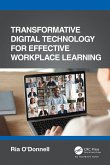Shahron Williams van Rooij
The Business Side of Learning Design and Technologies
Shahron Williams van Rooij
The Business Side of Learning Design and Technologies
- Gebundenes Buch
- Merkliste
- Auf die Merkliste
- Bewerten Bewerten
- Teilen
- Produkt teilen
- Produkterinnerung
- Produkterinnerung
The Business Side of Learning Design and Technologies provides a ready reference with actionable tools and techniques for recognizing the impact of learning design/technology decisions at the project, business unit, and organizational levels.
Andere Kunden interessierten sich auch für
![Designing Personalized Learning Experiences Designing Personalized Learning Experiences]() Helen FakeDesigning Personalized Learning Experiences183,99 €
Helen FakeDesigning Personalized Learning Experiences183,99 €![Charting the AI Transition in Education and Business Environments Charting the AI Transition in Education and Business Environments]() James HutsonCharting the AI Transition in Education and Business Environments206,99 €
James HutsonCharting the AI Transition in Education and Business Environments206,99 €![Transformative Digital Technology for Effective Workplace Learning Transformative Digital Technology for Effective Workplace Learning]() Ria O'DonnellTransformative Digital Technology for Effective Workplace Learning78,99 €
Ria O'DonnellTransformative Digital Technology for Effective Workplace Learning78,99 €![Globalised re/gendering of the academy and leadership Globalised re/gendering of the academy and leadership]() Globalised re/gendering of the academy and leadership206,99 €
Globalised re/gendering of the academy and leadership206,99 €![The Lighter Side of Technology in Education The Lighter Side of Technology in Education]() Aaron BacallThe Lighter Side of Technology in Education26,99 €
Aaron BacallThe Lighter Side of Technology in Education26,99 €![e-Learning and Social Networking Handbook e-Learning and Social Networking Handbook]() Frank Renniee-Learning and Social Networking Handbook202,99 €
Frank Renniee-Learning and Social Networking Handbook202,99 €![Blended Learning Solutions in Higher Education Blended Learning Solutions in Higher Education]() Neil HughesBlended Learning Solutions in Higher Education194,99 €
Neil HughesBlended Learning Solutions in Higher Education194,99 €-
-
-
The Business Side of Learning Design and Technologies provides a ready reference with actionable tools and techniques for recognizing the impact of learning design/technology decisions at the project, business unit, and organizational levels.
Hinweis: Dieser Artikel kann nur an eine deutsche Lieferadresse ausgeliefert werden.
Hinweis: Dieser Artikel kann nur an eine deutsche Lieferadresse ausgeliefert werden.
Produktdetails
- Produktdetails
- Verlag: Taylor & Francis
- Seitenzahl: 406
- Erscheinungstermin: 21. September 2017
- Englisch
- Abmessung: 229mm x 152mm x 24mm
- Gewicht: 712g
- ISBN-13: 9781138698161
- ISBN-10: 1138698164
- Artikelnr.: 57055098
- Herstellerkennzeichnung
- Produktsicherheitsverantwortliche/r
- Europaallee 1
- 36244 Bad Hersfeld
- gpsr@libri.de
- Verlag: Taylor & Francis
- Seitenzahl: 406
- Erscheinungstermin: 21. September 2017
- Englisch
- Abmessung: 229mm x 152mm x 24mm
- Gewicht: 712g
- ISBN-13: 9781138698161
- ISBN-10: 1138698164
- Artikelnr.: 57055098
- Herstellerkennzeichnung
- Produktsicherheitsverantwortliche/r
- Europaallee 1
- 36244 Bad Hersfeld
- gpsr@libri.de
Shahron Williams van Rooij is Associate Professor in the Learning Technologies Division of the College of Education and Human Development at George Mason University, USA.
List of Figures
List of Tables
Preface and Acknowledgements
Introduction
Part One: The Changing Practice of Learning Design and Technologies
Chapter 1 The Learning Design Profession: Your Job is What?
The Workplace Kaleidoscope
Seeking the All-Knowing Source
The Learning Design and Technologies Professional
Staying Relevant in a Dilbert(c) World of Change
Learning Design Profession Self-Check
Food for Thought
Up Next
References
Chapter 2 Designing to Improve Performance: It's All about Change
Organizational Change Management as a Field of Study
Becoming an Agent of Change
Change Management as the Un-Dilbert(c) Mindset
Designing for Change Self-Check
Food for Thought
Up Next
References
Chapter 3 Instructional vs. Non-Instructional Interventions: What's the
Difference?
Learning, Instruction, and Performance Interventions
The Learning Designer's Wheelhouse
Making a Smooth Handoff
Intervention Selection Self-Check
Food for Thought
Up Next
References
Chapter 4 Needs Assessment and Analysis: Is Instruction the Solution?
Needs Assessment: What the Scholars Say
Conducting a Needs Assessment: What the Practitioners Do
Doing More with What You Already Know
Some Lessons Learned
Needs Assessment Self-Check
Food for Thought
Up Next
References
Part Two: The Workplace Environment
Chapter 5 The Impact of Organizational Culture: Walking the Walk
The Nature of Organizational Culture and Sub-Cultures
Supporting a Culture of Learning
Navigating Your Organization's Cultural Waters with Dilbert(c) at the Helm
Organizational Culture Self-Check
Food for Thought
Up Next
References
Chapter 6 Stakeholder Analysis: Who's on First?
Stakeholder Theory and the Organization
Stakeholder Theory in Practice
Who's on First? Dilbert's(c) Guide to Stakeholder Analysis
Stakeholder Analysis Self-Check
Food for Thought
Up Next
References
Chapter 7 Emotional Intelligence: Catch-phrase or Competency?
Definitions, Models, and Measures: What the Scholars Say
EI in the Workplace: What the Practitioners Do
EI and How to Get It: What Would Dilbert(c) Do?
EI Self-Check
Food for Thought
Up Next
References
Part Three: Demonstrating the Value of Learning Design and Technologies
Chapter 8 Business Case Writing: Offense or Defense?
Evidence-Based Decision-Making: What Organizational Leaders (Should) Do
The Thinking Behind Your Business Case
Crafting Your Business Case
Dilbert's(c) Lessons Learned from Failed Business Cases
Business Case Self-Check
Food for Thought
Up Next
References
Chapter 9 Budgeting and Cost Management: Show Them the Money
The Basics: Never Lost in Translation
Collecting Financial Data: The Need to Know
Managing Costs: Avoiding Dilbert(c)-like Dilemmas
Budgeting and Cost Management Self-Check
Food for Thought
Up Next
References
Chapter 10 Project Management: People + Process = Results, Sometimes
The Current State of Project Management Research: In Flux but Progressing
Project Management and Instructional Design
Project Management Skills and Instructional Design Skills: The Shared
Must-Have's
Key Considerations: Avoiding the Dilbert(c) Project Experience
Project Management Self-Check
Food for Thought
Up Next
References
Chapter 11 Evaluation: Metrics, Measures, Dashboards
The Evaluation Landscape
Models for Decision-Makers
Tapping into Your Instructional Designer's Evaluation Toolkit
Lessons Learned for the Successful Use of Evaluation
Evaluation Self-Check
Food for Thought
Up Next
References
Part Four: Issues, Trends, and Opportunities
Chapter 12 Analytics: Tapping into the Enterprise Infrastructure
State of the Field
Learning Analytics in Academic vs. Non-Academic Workplace Settings
Learning Analytics for the Learning Designer
Learning Analytics Capability and How to Recognize It
Learning Analytics Self-Check
Food for Thought
Up Next
References
Chapter 13 Professional Ethics: It May Not Be Illegal but ....
Business Ethics: Not an Oxymoron
Ethics in the Field of L&D
Identifying Ethical Pitfalls
Dilbert's(c) Guide to Avoiding Ethical Pitfalls
Professional Ethics Self-Check
Food for Thought
Up Next
References
Chapter 14 Ten-Point Sanity Check: Avoiding Self-Inflicted Wounds
Reflective Practice: More than Just "Think Before You Act"
Self-Inflicted Wounds
The Un-Dilbert(c) Guide to Sustaining Reflective Practices
Reflective Practice Self-Check
Up Next
References
Chapter 15 Beyond Learning Design: Taking Your Career to the Next Level
From Organizational Career Paths to DIY
Know Before You Go: Your Career Thus Far
Defining and Implementing Plan B
Some Final Thoughts
References
Glossary
List of E-Suite Views Contributors
Index
List of Tables
Preface and Acknowledgements
Introduction
Part One: The Changing Practice of Learning Design and Technologies
Chapter 1 The Learning Design Profession: Your Job is What?
The Workplace Kaleidoscope
Seeking the All-Knowing Source
The Learning Design and Technologies Professional
Staying Relevant in a Dilbert(c) World of Change
Learning Design Profession Self-Check
Food for Thought
Up Next
References
Chapter 2 Designing to Improve Performance: It's All about Change
Organizational Change Management as a Field of Study
Becoming an Agent of Change
Change Management as the Un-Dilbert(c) Mindset
Designing for Change Self-Check
Food for Thought
Up Next
References
Chapter 3 Instructional vs. Non-Instructional Interventions: What's the
Difference?
Learning, Instruction, and Performance Interventions
The Learning Designer's Wheelhouse
Making a Smooth Handoff
Intervention Selection Self-Check
Food for Thought
Up Next
References
Chapter 4 Needs Assessment and Analysis: Is Instruction the Solution?
Needs Assessment: What the Scholars Say
Conducting a Needs Assessment: What the Practitioners Do
Doing More with What You Already Know
Some Lessons Learned
Needs Assessment Self-Check
Food for Thought
Up Next
References
Part Two: The Workplace Environment
Chapter 5 The Impact of Organizational Culture: Walking the Walk
The Nature of Organizational Culture and Sub-Cultures
Supporting a Culture of Learning
Navigating Your Organization's Cultural Waters with Dilbert(c) at the Helm
Organizational Culture Self-Check
Food for Thought
Up Next
References
Chapter 6 Stakeholder Analysis: Who's on First?
Stakeholder Theory and the Organization
Stakeholder Theory in Practice
Who's on First? Dilbert's(c) Guide to Stakeholder Analysis
Stakeholder Analysis Self-Check
Food for Thought
Up Next
References
Chapter 7 Emotional Intelligence: Catch-phrase or Competency?
Definitions, Models, and Measures: What the Scholars Say
EI in the Workplace: What the Practitioners Do
EI and How to Get It: What Would Dilbert(c) Do?
EI Self-Check
Food for Thought
Up Next
References
Part Three: Demonstrating the Value of Learning Design and Technologies
Chapter 8 Business Case Writing: Offense or Defense?
Evidence-Based Decision-Making: What Organizational Leaders (Should) Do
The Thinking Behind Your Business Case
Crafting Your Business Case
Dilbert's(c) Lessons Learned from Failed Business Cases
Business Case Self-Check
Food for Thought
Up Next
References
Chapter 9 Budgeting and Cost Management: Show Them the Money
The Basics: Never Lost in Translation
Collecting Financial Data: The Need to Know
Managing Costs: Avoiding Dilbert(c)-like Dilemmas
Budgeting and Cost Management Self-Check
Food for Thought
Up Next
References
Chapter 10 Project Management: People + Process = Results, Sometimes
The Current State of Project Management Research: In Flux but Progressing
Project Management and Instructional Design
Project Management Skills and Instructional Design Skills: The Shared
Must-Have's
Key Considerations: Avoiding the Dilbert(c) Project Experience
Project Management Self-Check
Food for Thought
Up Next
References
Chapter 11 Evaluation: Metrics, Measures, Dashboards
The Evaluation Landscape
Models for Decision-Makers
Tapping into Your Instructional Designer's Evaluation Toolkit
Lessons Learned for the Successful Use of Evaluation
Evaluation Self-Check
Food for Thought
Up Next
References
Part Four: Issues, Trends, and Opportunities
Chapter 12 Analytics: Tapping into the Enterprise Infrastructure
State of the Field
Learning Analytics in Academic vs. Non-Academic Workplace Settings
Learning Analytics for the Learning Designer
Learning Analytics Capability and How to Recognize It
Learning Analytics Self-Check
Food for Thought
Up Next
References
Chapter 13 Professional Ethics: It May Not Be Illegal but ....
Business Ethics: Not an Oxymoron
Ethics in the Field of L&D
Identifying Ethical Pitfalls
Dilbert's(c) Guide to Avoiding Ethical Pitfalls
Professional Ethics Self-Check
Food for Thought
Up Next
References
Chapter 14 Ten-Point Sanity Check: Avoiding Self-Inflicted Wounds
Reflective Practice: More than Just "Think Before You Act"
Self-Inflicted Wounds
The Un-Dilbert(c) Guide to Sustaining Reflective Practices
Reflective Practice Self-Check
Up Next
References
Chapter 15 Beyond Learning Design: Taking Your Career to the Next Level
From Organizational Career Paths to DIY
Know Before You Go: Your Career Thus Far
Defining and Implementing Plan B
Some Final Thoughts
References
Glossary
List of E-Suite Views Contributors
Index
List of Figures
List of Tables
Preface and Acknowledgements
Introduction
Part One: The Changing Practice of Learning Design and Technologies
Chapter 1 The Learning Design Profession: Your Job is What?
The Workplace Kaleidoscope
Seeking the All-Knowing Source
The Learning Design and Technologies Professional
Staying Relevant in a Dilbert(c) World of Change
Learning Design Profession Self-Check
Food for Thought
Up Next
References
Chapter 2 Designing to Improve Performance: It's All about Change
Organizational Change Management as a Field of Study
Becoming an Agent of Change
Change Management as the Un-Dilbert(c) Mindset
Designing for Change Self-Check
Food for Thought
Up Next
References
Chapter 3 Instructional vs. Non-Instructional Interventions: What's the
Difference?
Learning, Instruction, and Performance Interventions
The Learning Designer's Wheelhouse
Making a Smooth Handoff
Intervention Selection Self-Check
Food for Thought
Up Next
References
Chapter 4 Needs Assessment and Analysis: Is Instruction the Solution?
Needs Assessment: What the Scholars Say
Conducting a Needs Assessment: What the Practitioners Do
Doing More with What You Already Know
Some Lessons Learned
Needs Assessment Self-Check
Food for Thought
Up Next
References
Part Two: The Workplace Environment
Chapter 5 The Impact of Organizational Culture: Walking the Walk
The Nature of Organizational Culture and Sub-Cultures
Supporting a Culture of Learning
Navigating Your Organization's Cultural Waters with Dilbert(c) at the Helm
Organizational Culture Self-Check
Food for Thought
Up Next
References
Chapter 6 Stakeholder Analysis: Who's on First?
Stakeholder Theory and the Organization
Stakeholder Theory in Practice
Who's on First? Dilbert's(c) Guide to Stakeholder Analysis
Stakeholder Analysis Self-Check
Food for Thought
Up Next
References
Chapter 7 Emotional Intelligence: Catch-phrase or Competency?
Definitions, Models, and Measures: What the Scholars Say
EI in the Workplace: What the Practitioners Do
EI and How to Get It: What Would Dilbert(c) Do?
EI Self-Check
Food for Thought
Up Next
References
Part Three: Demonstrating the Value of Learning Design and Technologies
Chapter 8 Business Case Writing: Offense or Defense?
Evidence-Based Decision-Making: What Organizational Leaders (Should) Do
The Thinking Behind Your Business Case
Crafting Your Business Case
Dilbert's(c) Lessons Learned from Failed Business Cases
Business Case Self-Check
Food for Thought
Up Next
References
Chapter 9 Budgeting and Cost Management: Show Them the Money
The Basics: Never Lost in Translation
Collecting Financial Data: The Need to Know
Managing Costs: Avoiding Dilbert(c)-like Dilemmas
Budgeting and Cost Management Self-Check
Food for Thought
Up Next
References
Chapter 10 Project Management: People + Process = Results, Sometimes
The Current State of Project Management Research: In Flux but Progressing
Project Management and Instructional Design
Project Management Skills and Instructional Design Skills: The Shared
Must-Have's
Key Considerations: Avoiding the Dilbert(c) Project Experience
Project Management Self-Check
Food for Thought
Up Next
References
Chapter 11 Evaluation: Metrics, Measures, Dashboards
The Evaluation Landscape
Models for Decision-Makers
Tapping into Your Instructional Designer's Evaluation Toolkit
Lessons Learned for the Successful Use of Evaluation
Evaluation Self-Check
Food for Thought
Up Next
References
Part Four: Issues, Trends, and Opportunities
Chapter 12 Analytics: Tapping into the Enterprise Infrastructure
State of the Field
Learning Analytics in Academic vs. Non-Academic Workplace Settings
Learning Analytics for the Learning Designer
Learning Analytics Capability and How to Recognize It
Learning Analytics Self-Check
Food for Thought
Up Next
References
Chapter 13 Professional Ethics: It May Not Be Illegal but ....
Business Ethics: Not an Oxymoron
Ethics in the Field of L&D
Identifying Ethical Pitfalls
Dilbert's(c) Guide to Avoiding Ethical Pitfalls
Professional Ethics Self-Check
Food for Thought
Up Next
References
Chapter 14 Ten-Point Sanity Check: Avoiding Self-Inflicted Wounds
Reflective Practice: More than Just "Think Before You Act"
Self-Inflicted Wounds
The Un-Dilbert(c) Guide to Sustaining Reflective Practices
Reflective Practice Self-Check
Up Next
References
Chapter 15 Beyond Learning Design: Taking Your Career to the Next Level
From Organizational Career Paths to DIY
Know Before You Go: Your Career Thus Far
Defining and Implementing Plan B
Some Final Thoughts
References
Glossary
List of E-Suite Views Contributors
Index
List of Tables
Preface and Acknowledgements
Introduction
Part One: The Changing Practice of Learning Design and Technologies
Chapter 1 The Learning Design Profession: Your Job is What?
The Workplace Kaleidoscope
Seeking the All-Knowing Source
The Learning Design and Technologies Professional
Staying Relevant in a Dilbert(c) World of Change
Learning Design Profession Self-Check
Food for Thought
Up Next
References
Chapter 2 Designing to Improve Performance: It's All about Change
Organizational Change Management as a Field of Study
Becoming an Agent of Change
Change Management as the Un-Dilbert(c) Mindset
Designing for Change Self-Check
Food for Thought
Up Next
References
Chapter 3 Instructional vs. Non-Instructional Interventions: What's the
Difference?
Learning, Instruction, and Performance Interventions
The Learning Designer's Wheelhouse
Making a Smooth Handoff
Intervention Selection Self-Check
Food for Thought
Up Next
References
Chapter 4 Needs Assessment and Analysis: Is Instruction the Solution?
Needs Assessment: What the Scholars Say
Conducting a Needs Assessment: What the Practitioners Do
Doing More with What You Already Know
Some Lessons Learned
Needs Assessment Self-Check
Food for Thought
Up Next
References
Part Two: The Workplace Environment
Chapter 5 The Impact of Organizational Culture: Walking the Walk
The Nature of Organizational Culture and Sub-Cultures
Supporting a Culture of Learning
Navigating Your Organization's Cultural Waters with Dilbert(c) at the Helm
Organizational Culture Self-Check
Food for Thought
Up Next
References
Chapter 6 Stakeholder Analysis: Who's on First?
Stakeholder Theory and the Organization
Stakeholder Theory in Practice
Who's on First? Dilbert's(c) Guide to Stakeholder Analysis
Stakeholder Analysis Self-Check
Food for Thought
Up Next
References
Chapter 7 Emotional Intelligence: Catch-phrase or Competency?
Definitions, Models, and Measures: What the Scholars Say
EI in the Workplace: What the Practitioners Do
EI and How to Get It: What Would Dilbert(c) Do?
EI Self-Check
Food for Thought
Up Next
References
Part Three: Demonstrating the Value of Learning Design and Technologies
Chapter 8 Business Case Writing: Offense or Defense?
Evidence-Based Decision-Making: What Organizational Leaders (Should) Do
The Thinking Behind Your Business Case
Crafting Your Business Case
Dilbert's(c) Lessons Learned from Failed Business Cases
Business Case Self-Check
Food for Thought
Up Next
References
Chapter 9 Budgeting and Cost Management: Show Them the Money
The Basics: Never Lost in Translation
Collecting Financial Data: The Need to Know
Managing Costs: Avoiding Dilbert(c)-like Dilemmas
Budgeting and Cost Management Self-Check
Food for Thought
Up Next
References
Chapter 10 Project Management: People + Process = Results, Sometimes
The Current State of Project Management Research: In Flux but Progressing
Project Management and Instructional Design
Project Management Skills and Instructional Design Skills: The Shared
Must-Have's
Key Considerations: Avoiding the Dilbert(c) Project Experience
Project Management Self-Check
Food for Thought
Up Next
References
Chapter 11 Evaluation: Metrics, Measures, Dashboards
The Evaluation Landscape
Models for Decision-Makers
Tapping into Your Instructional Designer's Evaluation Toolkit
Lessons Learned for the Successful Use of Evaluation
Evaluation Self-Check
Food for Thought
Up Next
References
Part Four: Issues, Trends, and Opportunities
Chapter 12 Analytics: Tapping into the Enterprise Infrastructure
State of the Field
Learning Analytics in Academic vs. Non-Academic Workplace Settings
Learning Analytics for the Learning Designer
Learning Analytics Capability and How to Recognize It
Learning Analytics Self-Check
Food for Thought
Up Next
References
Chapter 13 Professional Ethics: It May Not Be Illegal but ....
Business Ethics: Not an Oxymoron
Ethics in the Field of L&D
Identifying Ethical Pitfalls
Dilbert's(c) Guide to Avoiding Ethical Pitfalls
Professional Ethics Self-Check
Food for Thought
Up Next
References
Chapter 14 Ten-Point Sanity Check: Avoiding Self-Inflicted Wounds
Reflective Practice: More than Just "Think Before You Act"
Self-Inflicted Wounds
The Un-Dilbert(c) Guide to Sustaining Reflective Practices
Reflective Practice Self-Check
Up Next
References
Chapter 15 Beyond Learning Design: Taking Your Career to the Next Level
From Organizational Career Paths to DIY
Know Before You Go: Your Career Thus Far
Defining and Implementing Plan B
Some Final Thoughts
References
Glossary
List of E-Suite Views Contributors
Index








